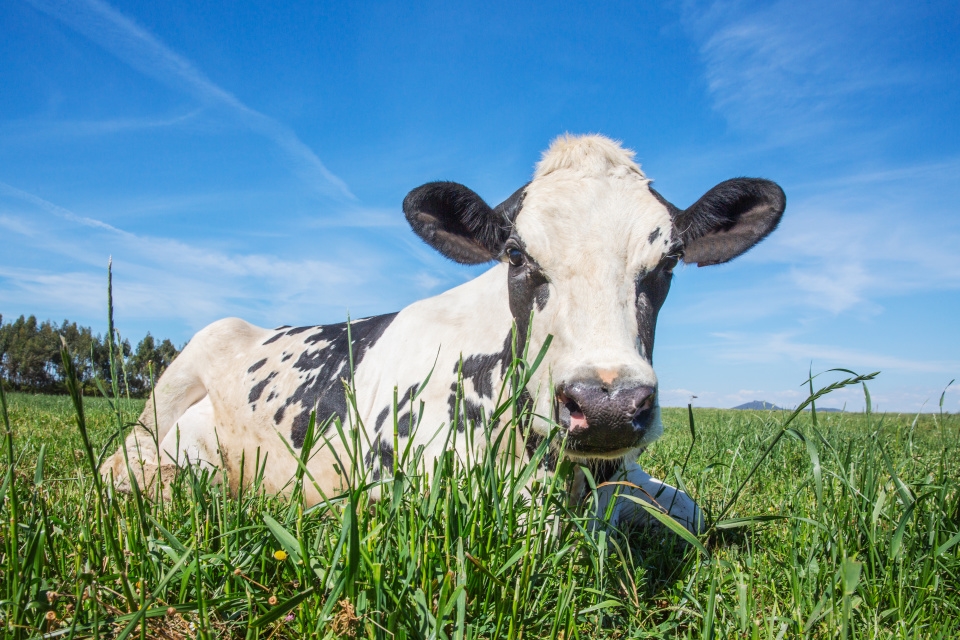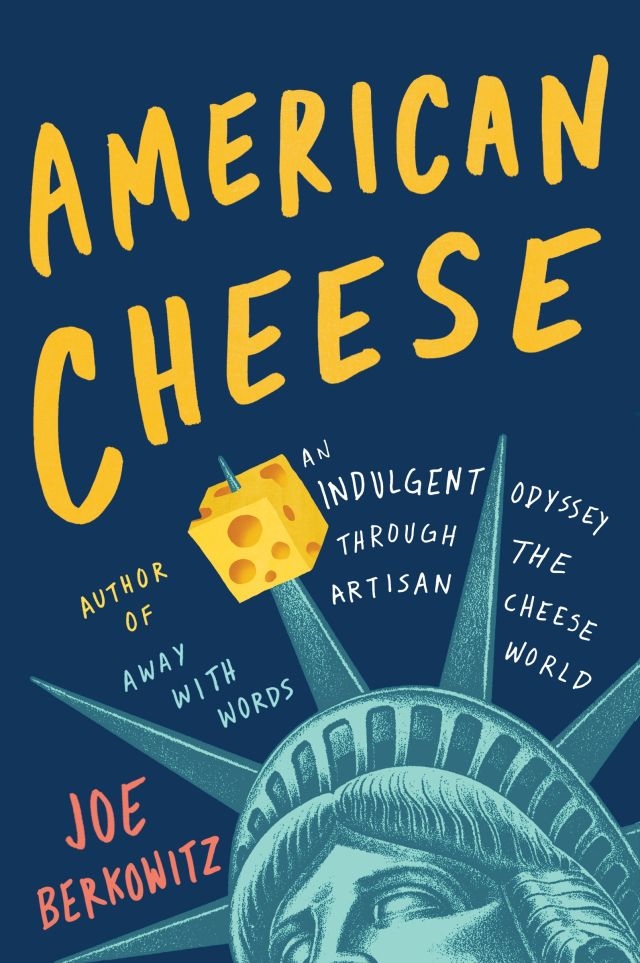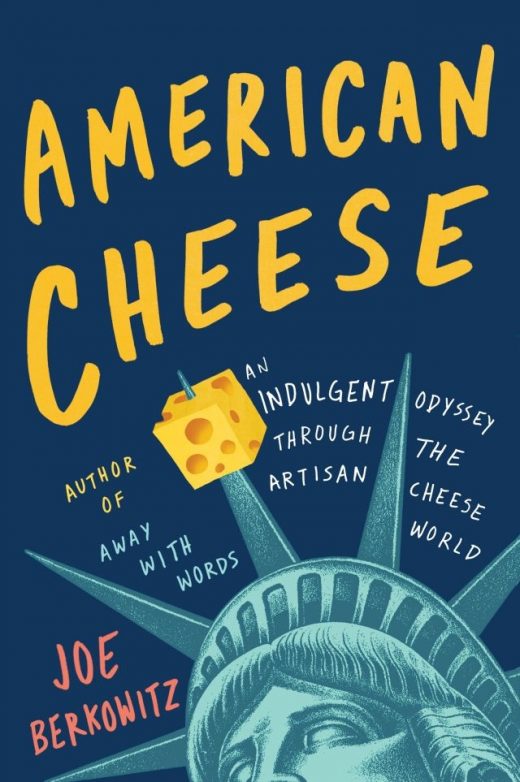Hitting the Books: What really goes into your artisanal cheese

Keep your white picket fences and 2.5 suburban-raised children, there is nothing more American that tearing into an individually-wrapped slice of hyper-processed, luminescently orange milk-derived consumption commodity. But American is not the only variety of national cheese, not by a long shot — our country is chock full of independent creameries busy every day converting millions of liters of cow juice into any number of varieties of the deliciously delicate dairy products we enjoy.
In American Cheese: An Indulgent Odyssey Through the Artisan Cheese World, author Joe Berkowitz takes readers on an incredible journey through the heart of the modern cheese-making/cheese-enjoying industry. In the excerpt below, Berkowitz visits an artisanal cheese facility in Northern California, bonds with “the girls” who make the milk, and learns how green making orange can be.

From AMERICAN CHEESE by Joe Berkowitz. Reprinted with the permission of the publisher, HarperCollins Publishers. Copyright © 2020 by Joe Berkowitz.
There is zero cell reception on this particular winding stretch of Highway 1, so I’m unable to either look up how to get unlost or let my host know I’ll be late. All I can do is continue driving along the foggy bay that keeps area restaurants up to their elbows in oysters, trying to remember roughly where I’m supposed to go. Just as I’m about ready to give up, I find a sloping gravel path riven through a grassy hill that leads to Point Reyes Farmstead Creamery.
As my car crawls through a light drizzle, alongside a herd of Holsteins and past two chrome colored feed silos, I see a giant black blob rising from the ground, hemmed in by a short chain link fence. From its bulbous outward appearance, I’d never have guessed it was a methane digester filled with electricitygenerating poop fumes. I hang a right by a stable filled with more cows, past a small fleet of ATVs, and park near the head office, which looks like the kind of resort that might have a lobby DJ spinning in side. Across from the reception desk is the entrance to Fork, the folksy-fancy culinary and educational center where Point Reyes hosts agribusiness event meals and corporate retreats. (A group from Whole Foods is currently in there, talking quarterly reports over crumbly blue cheese.) It looks like the type of space a couple might get married in, depending on how much they love cheese and are indifferent to jokes about it.
Although the Giacomini family, who owns and runs the business, appears to be doing very well, that wasn’t the case twenty years ago. Like many other smaller dairy farms around the country, they had been finding it difficult to stay competitive selling only fluid milk. America simply had too much, and it sold for way too cheap. By the late 1990s, when the prospects of keeping the farm began to look bleak, Bob Giacomini considered selling. The only alternative, it seemed, was to diversify. Switching to commodity cheese, which is what a majority of dairy farmers make and a majority of Americans eat, would leave him subject to the fickle whims of the Chicago Mercantile Exchange, which determines its fluctuating price. If he made artisan cheese instead, though, Bob could charge whatever people were willing to pay.
He and his wife, Dean, decided to go for it. Since they didn’t think they alone could do all the work of converting to artisan cheesemaking, they asked their four adult daughters to come along on this uncertain cheese adventure. Three said yes, and together they produced California’s first artisanal blue cheese. Nearly two decades later, Point Reyes Farm stead’s Original Blue has become a nationwide cheese shop staple, affording the Giacominis this impressive, state-of-the-art facility.
Many other dairy farmers tried turning to artisan cheese as a means to save their farms before the Giacominis, and many more would try afterward. Not very many are able to make it work. “You caught us on one of our rainy weeks,” says a Point Reyes employee named Stacey in a navy parka. Stacey has a freckled face and a frizzy ponytail, and even though she looks young enough to belong to a sorority, she has the composure and infectious pleasantness of a local morning news anchor. She hands over an umbrella as she greets me in the lobby, and I follow her through the doors back out into the midmorning mist.
The first place we visit is the milking room, located in a bunker just across from the creamery. Each machine is an octopusian jumble of tubes, all of them ending in apparatuses topped with suction cups. It seems like a room where cows might gear up before a scuba diving mission.
For some reason, it’s disappointing to find out that cows are milked by machines and not by hand, like they are in every movie or TV show to ever feature a cow. It’s like the first time I went to a casino and saw everybody just pushing buttons instead of pulling the slot machine handles. Little did I know at the time just how advanced milking technology has become. A couple of months later, I would visit Rogue Creamery’s farm in Oregon, where the cows milk themselves. Whenever they’re ready, they simply clomp over to a waiting vestibule, where milking robot arms first spray their udders with iodine and then latch on and start sucking, the machine pinging the farmer’s phone if there’s ever a problem. (Old McDonald has an app, EIEIO.)
“We pride ourselves on our sustainable practices,” Stacey proudly announces, pointing out the solar panels on top of the milking room.
Sustainability is a buzzword lightly tossed around in restaurants and coffee shops and Peloton classes, and my grasp on it is tenuous at best. I know, at least, that it is a good thing and I am in favor of it. The concept fully sinks in for me, though, when Stacey explains, in a relentlessly upbeat tone, how Point Reyes uses byproducts from the farm and from other local industries in every way they can. They use cottonseed from cotton farmers.
They use brewer’s grain from the nearby Lagunitas brewery. They use solar energy from the sun. Not only are these byproducts super affordable or free, they also represent the concept of using the whole buffalo, and not letting resources go to waste.
“The biggest byproduct on our farm is methane from the cow’s poop,” Stacey says as we stroll past a chillout area where cows lay in repose on dirt beds, their legs folded up underneath them and their butts jutting out. “It, uh, comes without fail, so we have to put it to good use somehow.”
Converting cow poop into useful energy is the ultimate example of turning lemons into lemonade, and a stronger candidate for that expression’s mantle in my opinion. When life hands you poop, make power. All the waste the cows leave behind on the pasture stays there, because it’s too hard to capture from the porous earth, and goes on to fertilize new grass for those same cows to eventually eat.
Yada, yada, the circle of life, and so forth. The poop in the barn, on the other hand, slides down a gravity slope system, which the dairymen flush out with recycled water a couple times a day. That waterborne poop floats from the barn to the Giacominis’ methane digester, which extracts enough gas from it to power 60 percent of the farm on average, including the creamery.
“Another byproduct is whey,” Stacey says as we head toward the barn, “which is high in protein, so we feed it right back to the girls.”
Once I realize that Stacey means the cows and not the Giacomini sisters, whom she also refers to as “the girls,” a shiver travels up my spine. The idea of cows ingesting whey from their own milk sounds an awful lot like cannibalism. It’s at least cannibalism adjacent. But it seems from Point Reyes’ success that they know exactly what they’re doing and only feed these cows substances that enhance their lives. “Happy cows make happy milk” is a dairy industry slogan that sounds like it was written by cows but it’s actually true. Scientific studies show that stressed out animals secrete cortisol and other non-delicious hormones in their milk. You can probably taste the psychic trauma trapped in the milk of poorly treated cattle, and I bet it tastes like shit.
I survey the cows and try to discern their level of happiness. The eightball-like pupils in their wide-set eyes reveal nothing. They look healthy, though, each with a beefy ripple of ribs. At least part of the reason why, as it turns out, is because they come from good stock.
“We source our semen from around the world,” Stacey says as the cows meander past. “From professional breeders who advertise traits like longevity, high production, and strong legs.” I look at the cows a little differently, now that I know they’re genetically superior specimens.
Months later, I’ll actually get a glimpse at a semen catalog where professional breeders advertise bulls with names like Taurus Commander X Force alongside pictures of his progeny, with stats on their milk production. It sounds an awful lot like eugenics for cows. It’s at least eugenics-adjacent.
“Our herd manager and master cheesemaker are in constant communication with our nutritionist about how to best feed our girls and how it will affect the milk,” Stacey continues. “Wait, the cows have a nutritionist?”
“Uhhuh,” she says. “Dr. Kennedy looks at all the data we get from the milking barn and he decides whether they need more sugars or more omega3s, and we fluctuate as needed.”
Incredible. I picture a team of doctors in lab coats taking notes as an electrode-covered cow runs on a treadmill, like a bovine Ivan Drago. These cows are being optimized in every way and getting more help with their fitness than I can afford to get with mine. They’re leading an aspirational lifestyle.
Soon, we come upon an isolated section of the stable with a lumpy dirt floor, which Stacey refers to as the maternity ward. A Holstein with haunted eyes is helping a wobbly baby calf, the size of a Golden Retriever, remain standing beneath her. She was apparently born just a half hour ago.
“There’s the placenta,” Stacey says, pointing to a slurry of red, membranal goop that resembles a beached jellyfish in shape, consistency, and my desire to avoid it. I’ve barely recovered from the sight when Stacey mentions that the mama cow will soon be eating it.
“Wow,” I say, and then bite the inside of my cheek to keep from barfing. It is in this weak condition that I hear what’s coming next, the information that turns my whole cheese world upside down.
“The girl calves go on to join our herd,” Stacey says, in the exact key of chipper she’s said everything else, “and the boys be come beef cows.” Whatever she says after that gets a little fuzzy. Because I’m spiraling.
For the last ten years, I’ve been a vegetarian. It’s part of my identity. The words “beef cow,” however, pierce the veil of my deeply internalized denial. Suddenly, I see my own complicity in all the hamburgers I’ve forsaken for seitan. It had somehow never occurred to me that having a steady supply of milk is contingent on cows being pregnant all the time, and while girl cows keep producing milk for many years, boy cows are single-use only.
Their purpose in dairy starts and ends with sperm donation. And for all the cost associated with raising a calf to adulthood, you might as well just artificially inseminate. The longer the boy cows stay on the farm, the more they soak up resources, take up space, and exude methane. Ideally, these unmilkable boy cows would be able to roam free on a utopian cattle sanctuary, but this isn’t an ideal world. Meanwhile, the boundless demand for beef continues. So, boy calves become beef cows: pre-veal. That’s why we associate cows with the name “Bessie.” All the Benjys are dead.
I had eaten cheese, guilt-free, my whole life—a decade of which I spent patting myself on the back for being kind to animals as a vegetarian. Now I understood that artisan cheese simply could not exist without people eating meat, the dairy industry and the beef industry working in symbiotic harmony. Even if dairy farmers didn’t sell their boy cows to be butchered, there was still the matter of rennet, the cheesemaking enzyme that comes from a calf’s fourth stomach. I suddenly realized that it can’t possibly be extracted from those calves with a syringe like I’d quietly told myself when I first heard about rennet. Deep down, I probably always knew how farmers got it.
Even in the best conditions, at a top-of-the-line farmstead creamery where the animals are mostly treated like guests at a day spa—happy cows making happy milk—this process was still pure subjugation. I had shielded myself from some hard truths about it in order to remain a blissful, cheese-loving vegetarian. But I couldn’t do that anymore. Santa isn’t real, love doesn’t always last, and baby boy cows are slaughtered for rennet and veal.
(18)



